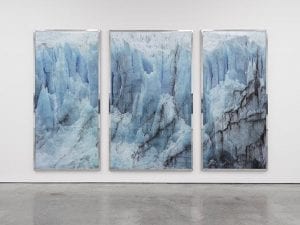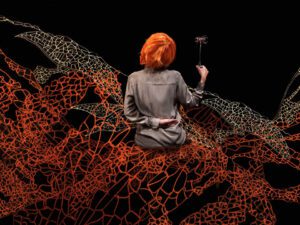“To create one’s world in any of the arts takes courage.” These are the words of Georgia O’Keeffe, (1887-1986) the modernist painter whose name is synonymous with flowers. O’Keeffe is part of a long tradition of trailblazing women artists who have engaged with the natural world. Ana Mendieta (1948- 1985) is remembered for her Siluetas (1973-1978) series, in which she burnt and carved impressions of her body into landscapes in Mexico and Iowa. At the same time, Judy Chicago (b. 1939) was looking to inject a “feminine impulse” into the environment through smoke and fireworks. Nancy Holt (1938-2014), meanwhile, broke down barriers in the predominately male field of large-scale outdoor installation. These individuals are united by the desire to spark new conversations and spread messages about the natural world, rather than dominate it. In Women, Art and Society (Thames & Hudson, 2020), Whitney Chadwick writes: “Work in the landscape often intersected with a desire by women artists to work in public places in order to affect the lives of people outside the closed confines of the art gallery and museum worlds.” Australian photomedia artist Tamara Dean (b. 1976) is part of this history. The Aesthetica Art Prize alumnus makes portraits in which figures immerse themselves in nature – swinging from branches or hiding amongst bright blooms. Right now, she’s experimenting with underwater photography, pushing the limits of physical endurance and showing us what can be achieved in the studio. Themes of empowerment, authenticity and play are central to her works. Ultimately, they are rooted in the indelible links between human beings, the spaces we inhabit, and the threats facing all life on Earth.

A: What’s your story? Can you recall the first time you held a camera? Tell us how you started making artwork.
TD: I can’t remember the first time I held a camera, although the most memorable photograph from my early years would have to be a portrait I made of my youngest sister Hannah, aged 10, in our local national park. I remember asking Hannah to run her hair in a stream and then to look directly into the camera. There was a sense of depth and strength in her eyes which came through in the photograph. She seemed wise beyond her years. I started to see how photography could tap into deeper emotions, to depict the nuances and complexity of the human condition. I also began to experience the joy found in photographing the people close to me.
A: The images in High Jinks in the Hydrangeas (2021) are extremely physical; you’re jumping from trees, tumbling down hills and being smothered by flowers. Can you describe the experience of creating these particular works?
TD: I started making this series during the first lockdown in 2020 whilst in social isolation with my husband and our two teenage kids on our six-acre property in Australia. I used photography as a form of escapism from pandemic-induced anxieties and made a habit of heading outside every afternoon to photograph my own body amongst the landscape. I would immerse myself in the freezing water of our dam, bury myself in natural crevices and abandoned wombat burrows, enclose my body in blossoming flowers and try to capture movement with long exposures. At the end of each day, my skin was marked with bruises, scratches and bites, yet I emerged from the experience re-energised by the intimate physical sensation of being alive. I would say, in hindsight, that I created my own rites of passage. I used physical challenges to push myself into a transitional space that helped me grapple with our new, radically altered, reality. You’ll see that, at times, I’m emboldened within the landscape. Elsewhere, I’m fleeing from an invisible threat. This reflects my dual psychological response to the pandemic, and to the bushfires which terrorised my life only a few months earlier.

A: High Jinks follows an earlier series, In Our Nature (2018), in which groups of figures become intertwined with bushes, leaves and, eerily, caught under ice sheets. Is there are much deeper meaning behind this collection?
TD: In Our Nature was the first series in which I was trying to overtly demonstrate the connection between humans and nature. It’s a symbolic reminder that we are neither separate from nor superior to our surroundings. This series acknowledges that we are a part of a wider ecosystem, and that to wreak destruction upon our environment is to ultimately wreak destruction upon ourselves. For this collection, which is set in the Adelaide Botanic Garden, I wanted to connect seasonal changes in flora with the ages of the people in the photographs. I staged interactions between the models and the plants at particular points in their lives and life cycles.
A: Your work taps into important ecological questions. Do you think art and photography can make a tangible difference in response to a state of climate emergency?
TD: To create real and significant change in the face of the climate crisis there needs to be a culmination of action across the breadth of society and its different sectors. We must unite behind a shared intention to tackle these momentous challenges together. The power of art and photography can be found within its contribution to this conversation. I try to affect change by using beauty to raise difficult topics. People might switch off when they feel overwhelmed by the size of the problems we are facing. My images offer a different viewing experience to that of media reports or widely-disseminated documentary shots – like Jason Davies’ powerful, dronecaptured image of the major 2020 dust storm in New South Wales, or Konstantinos Tsakalidis’ deeply affecting picture of a Greek woman fleeing from her home in 2021. Instead, my various series provide a gentler and more conceptual way of keeping climate awareness at the forefront of viewers’ minds.
A: Human bodies – and, in particular, women’s bodies – are recurring motifs. Why do you return to this subject?
TD: I have always been inclined towards photographing women. Having grown up as the eldest of two sisters, I am comfortable in female company, and I lean into this ease in relationships with women. I find it a particularly intuitive and positive space in which to create. It is important for me to represent the power and strength to be found in womens’ experiences. I want to strip back the constructs of contemporary life and depict humans as powerful, yet vulnerable, mammals.

A: There’s something surreal about your pictures. Who – or what – do you consider to be your biggest influences?
TD: In my early career, I was drawn to photographers such as Mary Ellen Mark, Sally Mann and the late Australian photographer Carol Jerrems. They all had a way of photographing women and girls that portrayed their strength and power. Their works felt unflinchingly honest and immediately pulled me in to potent narratives. Mann’s Immediate Family (1984-1991), for example, captures the wildness of youth, with children playing freely amidst untamed American landscapes. Mark, meanwhile, chronicled the experiences of Erin Blackwell (aka Tiny) and her family over 32 years, and Jerrems made intimate portraits of friends. I am also influenced by artists such as John William Waterhouse, a Pre-Raphaelite, and Norman Lindsay, the Australian painter and etcher. Their works are particularly influential when it comes to how I use colour and how I position evocative figures in the landscape.
A: Tell us about your recent still life series, The Suspended Moment (2023). It appears to be set underwater. Is it made using postproduction techniques, or in the studio?
TD: This series is created in an underwater studio I had built on our property in regional New South Wales. Each scene was meticulously arranged, each object weighted to keep it in position. My teenage children assisted me in placing the objects and releasing the fruit, flowers, et cetera. The bubbles you see are the air they are breathing out; they are hidden behind, and underneath, a table we submerged in the pool.
A: Last year you released your monograph with Thames & Hudson. It’s described as “laden with risk and chance and adventure.” Is spontaneity and fun important to you?
TD: My shoots are often quite physical, and I certainly aim to create a space which encourages spontaneity. There is a sense of the absurd in the making of my images, and I think this leads to an enjoyable experience for all involved. That said, these shoots often take place in challenging environments, almost always at dusk, which can sometimes be cold and uncomfortable for the models. I try to keep everyone active and finish the session within a short time period. I had one lovely model tell me that our shoot was an experience for her bucket list – she didn’t realise she needed it until it happened. I think there was a sense of relief and achievement there. She’d shown real endurance, and it was empowering.

A: Has your practice changed and developed over time?
TD: My practice has evolved substantially over the past 20 years. My early works, like Ritualism (2009) and Only Human (2011), questioned and explored the relevance of spirituality and rites of passage in contemporary western society. I used the natural world as a backdrop for figures heavily inspired by Pre-Raphaelite paintings. More recently, I have managed to distill the conceptual narrative of my work down to one simple point: humanity is neither separate from, nor superior to, nature. Right now, I’m making work acknowledging that we are a part of this world and are as vulnerable to the same environmental pressures as every other living creature. The difference being that the power and responsibility lies with us.
A: What’s next for you? Do you have plans for 2024?
TD: At this stage, I am loving working in my underwater studio. I may not have much time with it left, though, as we are selling our house, so it’s difficult to say what is to come in 2024. I am always trying to challenge myself and to push the medium. I enjoy incorporating sensory elements into my work, so perhaps scent, texture and sound elements will emerge. Whatever happens next will be a surprise for me, too!
Tamara Dean
Michael Reid, Sydney
Worlds: Eleanor Sutherland
Image credits:
1. Tamara Dean, Tumbling through the treetops. Image courtesy the artist.
2. Tamara Dean, Elephant Ear (Alocasia odora) in Autumn. Image courtesy the artist.
3. Tamara Dean, Night Garden. Image courtesy the artist.
4. Tamara Dean, Wandering mind. Image courtesy the artist.
5. Tamara Dean, I wrap my face in her cloak of petals and breathe deeply. Image courtesy the artist.





